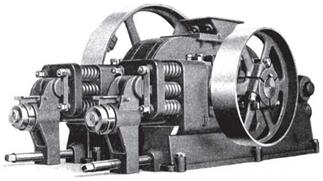The Blake crusher had its origin in a decision by the town council in New Haven, Connecticut, in 1852 to build a 3.2-km road in the center of the town using the MacAdam process. Eli Blake was one of the townsmen responsible for planning the road, and he realized that the cost would be reduced if a machine could break the quarried rock faster
|
|
FIGURE 5.9 Typical roll crusher (Richards and Locke 1940)
and cheaper than the slow and costly hand-breakage method. The crusher he invented was accepted rapidly by the stone industry and was said “…to do the work of 100 men in a given time and at less than one third the cost” (Dickinson 1945). Blake’s inventive brilliance is shown by the fact that Blake-type jaw crushers are still widely used today and the design has changed little in its essentials from his original design.
Eli Blake …conceived, the stone breaker in all its parts, even to their weight and strength, before ever a machine was made. (Dickinson 1945)
All of the large, heavy duty primary crushers of the jaw type are built around the Blake principle which, for simplicity and brute strength, is unsurpassed by any mechanism thus far devised for rock and ore breaking. (McGrew 1950)
The jaw crusher Blake designed in 1853 and patented in 1858 was one of the great inventions of size-reduction machines (Dickinson 1945). The crusher, shown in Figure 5.10, had a fixed jaw and a moving jaw that converged at the discharge end. The moving jaw pivoted on a shaft at the top, its base had a reciprocating movement of about 12.5 mm, and it was driven through a toggle. The toggle joint applied immense force to a rock held between the jaws as it straightened and shattered any brittle rock, irrespective of its hardness. A fly weight could be added to provide extra force to push the moving jaw through the crushing zone.
The early Blake crushers operated at 5-15 tph depending on the size of product, but their capacity increased considerably as larger units were built. Although they were used extensively for road building, it was 1861 before they were used to crush ore. But the immediate success of the Blake crusher in a plant on the Comstock lode in Nevada dispelled all hesitation about using them in mineral processing plants. The Blake jaw crusher was the first success that emerged from the plethora of inventions in the 19th century for size reduction of rocks and pebbles.

